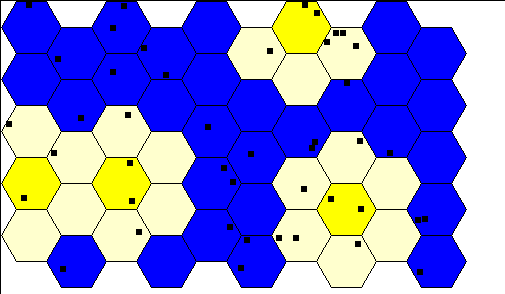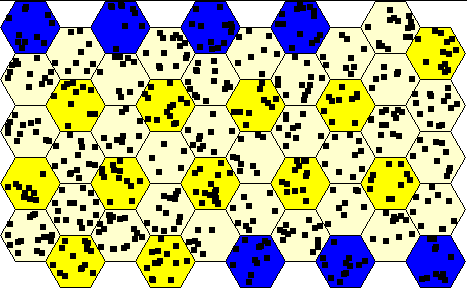Space Time Reservation Multiple Access
Jean-Paul Linnartz
Department of Electrical Engineering and Computer Sciences
University of California at
Berkeley
Space Time Reservation Multiple Access (STRMA) is a method to allow multiple portable
terminals to access a
communications infrastructure. It combines
frequency reuse (in space or area) with multiple access. The goal is to develop new radio
access techniques that are better suitable to bursty multi-media traffic.
STRMA can be interpreted as a spatial extension of the Packet Reservation Multiple Access (PRMA)* developed at
Winlab Rutgers University,
.
PRMA is a framed access scheme with
frames of a fixed number of slots. If a terminal has a series of packets or speech segments to
transmit, it competes for access in any free slot. If it successfully captures the base station,
the terminal gains reservation in the corresponding slots of the next frames, until it releases
the reservation.
In PRMA, adjacent cells use different carrier frequencies according to a cellular reuse plan,
but in STRMA we synchronize base stations and terminals at slot level. Time slots are
common to all cells, and all cells use the same carrier frequencies. However, if a terminal
gains a reservation in one cell for certain time slots, the base stations of the first tier of
surrounding cells inhibit all other terminals to use the same time slots. Hence, reservations
occur not only in time domain, as in PRMA, but also in space.

Cellular Network. This figure illustrates a possible sample of an STRMA process, during one
particular time slot, with idle (blue), busy (yellow) and inhibited cells (white).
Initial simulations revealed that for a uniform distribution of speech terminals, STRMA with
frames of 21 slots outperforms conventional PRMA with 7 slots per frame and a three cell
reuse pattern. We addressed a system with 5 erlang per cell and a speech activity of 0.4 (40
%) according to a Markovian on-off process with average duration of speech burst of 1
second and average length of a gap of 1.35 seconds. The speech clipping probability for
PRMA was about 0.5% and 0.2% for STRMA, while both systems use the same spectrum
bandwidth. With non-uniform distributions of users, we expect a further performance gain. The
STRMA system remained very efficient, also at higher message traffic
loads.

This figure illustrates a possible sample of an STRMA process with very heavy traffic , during one
particular time slot, with idle (blue), busy (yellow) and inhibited cells (white).
Thanks to John S. Davis, II, at U.C. Berkeley, and Casper van den Broek at T.U.
Delft.

